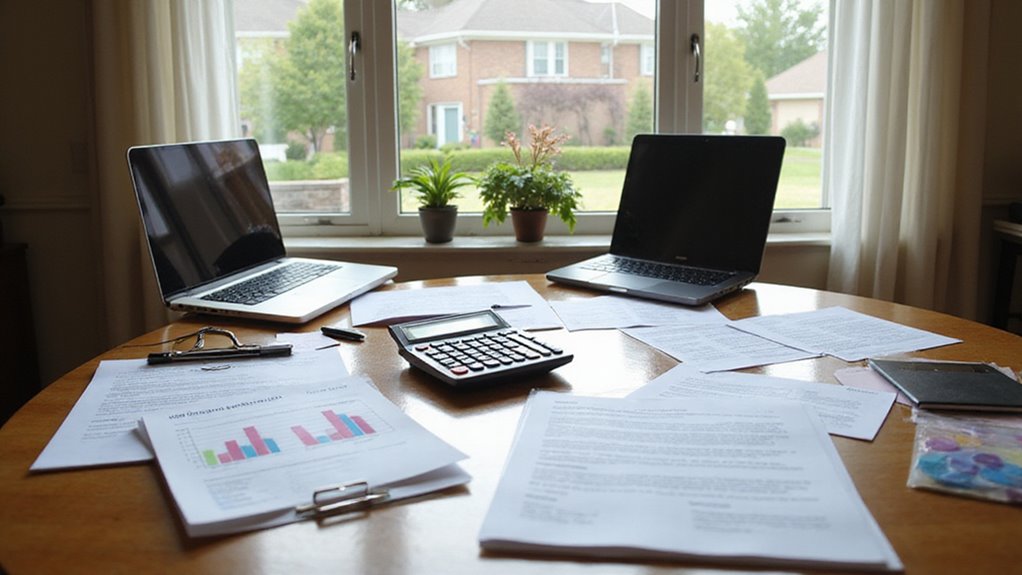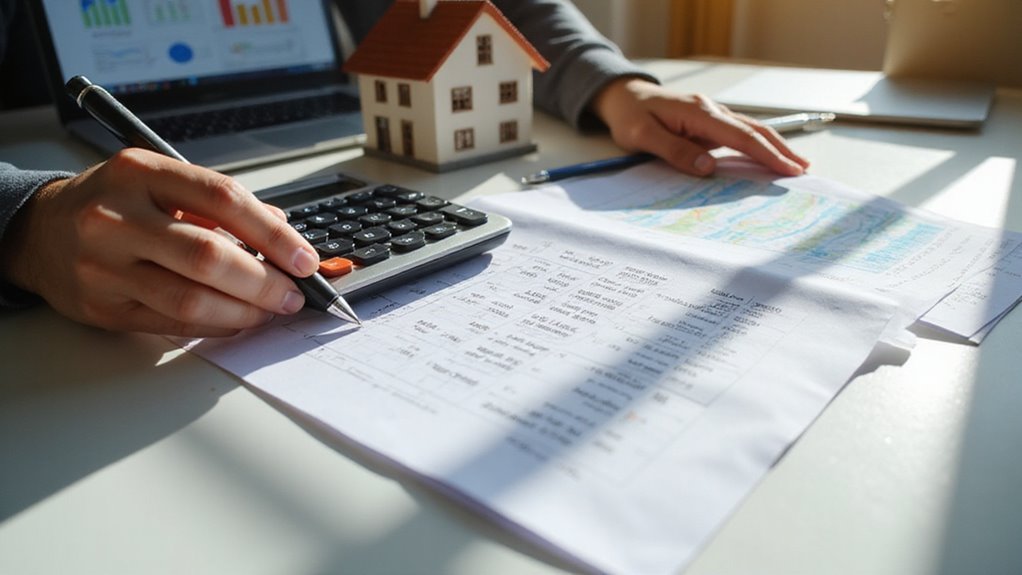Setting the right price for your rental property is a big challenge. Many owners worry they might price too high or too low. A wrong price can mean losing money or scaring off buyers.
It gets harder because rental properties aren’t like regular homes. You must think about rental income, tenant leases, and local demand. Sellers often overlook these details and make costly mistakes.
The best way to price a rental property for sale is to use both market data and the property’s income details. This method attracts serious buyers and helps you avoid common errors. You get the best value and a faster sale. This blog will guide you step by step through pricing your rental property right.
Key Takeaways
- Analyze recent sales of comparable rental properties in your area to determine current market value.
- Calculate net operating income (NOI) and use the cap rate to assess fair market pricing for investors.
- Consider property condition, recent upgrades, and occupancy rates to adjust your asking price.
- Review local market trends, rental demand, and future appreciation potential to set a competitive price.
- Consult professional appraisals and local real estate experts for accurate valuation and effective pricing strategy.
Understanding Market Value Versus Investment Value

Market value is what buyers are willing to pay in the current market. It depends on your property’s location and market activity. If the area is popular, you may get a higher price. Companies like Greg Buys Houses can help you understand fair pricing based on actual market demand and streamline your selling process.
Investment value is different and depends on your personal goals. It looks at your expected income, costs, and how the property fits your plans. Buyers do not consider your investment value when making offers.
If you want to set a price, use recent sales and rental data from similar properties. Always remember that buyers will focus on market value. Strategic pricing means understanding and respecting this difference.
If you want to avoid the hassle and uncertainty of a traditional sale, consider working with local experts in the Oldham County, KY housing market who can provide a fair cash offer and a fast, hassle-free closing.
Analyzing Comparable Property Sales
To price your rental property correctly, you must look at similar properties recently sold nearby. These are called “comps” and help show the market value. If you skip this step, you may overprice or underprice your property.
Comps should be close in size, age, and features to your property. They must also have the same rent control rules and zoning restrictions. If these factors differ, the comparison may not be useful. One critical factor to check is whether each comp had a clear title, as this can greatly affect both the speed and reliability of the sale.
Look at the sales price, time on the market, and any special deals made between buyer and seller. If you use trusted sources like the MLS or property records, your information will be accurate. This approach helps make sure your price fits current market trends and legal rules. Looking at Crestwood, KY Real Estate Market Insights like median listing and sold prices can provide helpful benchmarks when analyzing comparable property sales.
Assessing Current Rental Income and Yield

To check if your rental property makes money, start by adding up all rent collected. Subtract costs like management fees and maintenance. If you have vacancies, account for lost income during those times.
Net operating income (NOI) is found by taking away operating expenses from gross income. Divide the NOI by the property’s market value to get the yield or capitalization rate. This rate helps investors judge if the property is a good deal. If you need to sell quickly, cash transactions can be completed in days, providing a fast and streamlined alternative to traditional sales.
If you want steady income, screen tenants carefully. Reliable tenants lower turnover and extra costs. Good property management also keeps rent collection on track and reduces unnecessary spending.
Before listing your rental for sale, consider pricing the house effectively as this ensures your property attracts serious buyers and provides a fair return on your investment.
Evaluating Tenant Leases and Occupancy Status
When evaluating tenant leases and occupancy, look at lease length and how many units are filled. Longer leases and high occupancy show steady rental income. If tenants often renew, this can mean less risk for buyers.
Check tenant background and payment history if possible. Good tenants who pay on time are attractive to future owners. If the property has many short-term leases, buyers may see it as less stable. It’s also important to consider if there are any health and safety concerns on the property, as these can affect both tenant satisfaction and buyer interest.
Provide clear records of all leases, renewal dates, and occupancy rates. This helps buyers understand the property’s income potential. Accurate information makes your property look more reliable and valuable.
You should also gather important documents related to the property, as having these on hand can streamline the selling process and make it easier for buyers to evaluate the investment.
Factoring in Property Condition and Upgrades

The condition of your property directly affects its value. Buyers look closely at both appearance and structure. If a property shows wear or needs repairs, buyers may offer less. Making the necessary repairs before listing can help instil trust in prospective buyers and potentially increase your final sale price.
Upgrades like new kitchens or energy-efficient systems can raise the price. Data shows homes with updates sell for 8-12% more. Outdated features or visible issues often lower offers.
You should keep a record of all repairs and improvements. If you can show regular maintenance, buyers feel more confident. Cost-effective upgrades and good curb appeal can help you get better offers. Enhancing your curb appeal not only attracts more buyers but can also speed up the selling process.
Considering Local Market Trends and Demand
You should always consider local market trends and demand when pricing your rental property. Local prices depend on what similar homes have recently rented for. Current demand in your area also affects how much you can charge.
Check recent rental data for similar properties nearby. If zoning rules are strict, fewer buyers may be interested, which can lower value. Higher property taxes in your neighborhood can also make buyers less willing to pay top prices. If you want to avoid the hassle of listing your property and want a quick sale, understanding how these factors influence buyers can help you set a competitive price.
If there are few homes for rent, you may be able to ask for a higher price. Quick rentals often mean strong demand, so you might price more confidently. If new zoning rules appear, they can either raise or lower what people are willing to pay.
Looking at how cash home buyers value properties in your market can also help you set a realistic price that attracts serious buyers.
Calculating Potential for Future Appreciation

Evaluating a property’s potential for future appreciation means looking at key factors that affect value over time. Important factors include economic trends, neighborhood plans, and past price changes. If these show positive signs, the property might increase in value. Assessing future appreciation involves tracking economic trends, neighborhood plans, and price history to spot signs a property’s value may rise.
Local job growth and new infrastructure projects often lead to higher demand for housing. Zoning law changes can also affect property values in the area. If the area is improving, future appreciation is more likely. In some cases, limited financing options for certain properties can influence buyer demand and future value projections.
Historical sales data helps spot rising or falling price patterns. New amenities or public transit expansions nearby usually raise property values. Monitoring these updates gives you an advantage.
Landscaping costs and property management fees can affect long-term value. Good landscaping boosts curb appeal and attracts renters or buyers. Efficient management keeps the property in good condition.
When assessing appreciation potential, it is also important to understand the local market by researching sales trends and competition, as this influences both current pricing and long-term value. Using data and clear analysis helps you set the right price. If you combine these steps, you can better predict future value. This approach supports smarter rental property decisions.
Weighing Cap Rate and Return on Investment
To price your rental property strategically, you need to calculate an accurate cap rate and analyze projected ROI. These metrics give you a clear benchmark for performance against both the market and your financial goals. Use them to identify whether your property’s income potential justifies its price and your investment. Before listing, make sure to account for any outstanding liens or debts on the property that must be cleared prior to sale.
Calculating Accurate Cap Rate
The cap rate shows how much return a property can give you. To find it, divide the net operating income (NOI) by the current market value. This measure helps you compare properties and decide whether an investment is worthwhile.
You must include all operating costs when you calculate NOI. Expenses like maintenance, insurance, and property taxes should be counted. If you miss any costs, your cap rate will not be accurate.
Zoning rules can limit how you use the property and what rent you can charge. Always check local regulations before you finish your cap rate calculation. If zoning changes, your expected returns may change too.
Compare your property’s cap rate with similar buildings in the same area. This context shows if your investment is priced fairly. If your cap rate is much higher or lower, review your numbers and assumptions.
Analyzing Projected ROI
Projected ROI shows the possible long-term profit from your property. It includes cash flow, appreciation, and tax effects. If you want to set a fair price, you must look at ROI, not just the cap rate.
You should review past rent trends and likely vacancy rates. Maintenance costs also affect your actual returns. If local laws limit rent or changes, your profits may be lower.
Comparing ROI with similar properties helps you find your market advantage. Adjust your price if your ROI is higher or lower than others. Using both cap rate and ROI lets you make informed pricing decisions.
Accounting for Expenses and Net Operating Income

Net operating income (NOI) shows how much profit your property makes after expenses. To find NOI, subtract all operating costs from your total rental income. This gives a clear picture of your property’s real earnings.
Net operating income reveals your property’s true profit by subtracting operating costs from total rental income for a clear earnings snapshot.
You should list every expense. These include property taxes, insurance, maintenance, management fees, and utilities. If you miss any cost, your NOI will not be accurate.
Some expenses change each year, like insurance premiums. Others, such as property taxes, may stay the same. If you track these changes, you can plan your budget better.
Compare your NOI with similar properties. This helps you set a fair price. If your NOI is low, you may need to adjust your costs.
Accurate NOI calculations support strong pricing decisions. If you want to attract buyers or investors, clear financial data is vital. Proper analysis helps you get the best return on your property.
Reviewing Legal and Regulatory Factors
Legal and regulatory factors can change how you set your rental price. You must know the laws that affect your property before deciding on a price. These rules can limit how you use the property and who can rent it.
Zoning rules decide what you can do with your property. If there are strict rules, fewer people may want to rent from you. Local laws might also limit short-term rentals or set a maximum number of tenants.
Property disclosures are required by law. You must tell renters about issues like lead paint or damage. If you fail to disclose problems, it can hurt trust and lower your price.
Some areas have caps on how many properties can be rented. This can reduce your rental income if you are not careful. Local rules may also add extra costs for compliance.
If you follow these rules, you can avoid legal trouble and make smarter pricing choices. Always check the latest local laws before setting your price. If in doubt, ask a legal expert for help.
Highlighting Value-Add Opportunities
You can increase your property’s value by making smart improvements. These upgrades help raise rent and keep good tenants. Investors look for properties with strong income and low vacancy.
Modern kitchens and bathrooms often lead to higher rent. Updated spaces attract tenants who want comfort and style. If you invest in these areas, you could see a better return.
Curb appeal matters if you want to stand out. Fresh paint or new landscaping makes your property more inviting. Properties that look good from the outside tend to keep tenants longer.
If you add amenities, you may justify charging more rent. Features like in-unit laundry or smart technology are in high demand. Tenants often choose places with these modern conveniences.
If you focus on these upgrades, you can attract serious buyers. Your property will stand out as a high-value investment. This approach can improve your bottom line.
Leveraging Professional Appraisals
A professional appraisal gives you an accurate estimate of your property’s market value. Appraisers use recent sales and local trends to guide their evaluation. Their report helps you understand what your home is truly worth.
Appraisers look at your property’s condition and compare it to similar homes. They include luxury features, like pools or upgraded appliances, if you have them. Your home’s interior design and finishes can also add value.
If your property has modern layouts or unique details, the appraiser will note these. They may increase your valuation if your features stand out. You can use the appraisal to make smart selling or refinancing decisions.
Setting a Competitive Asking Price
A competitive asking price helps attract tenants and maximize your rental income. You should use an appraisal and local market data to set the price. If the price is fair, you are more likely to get interested renters.
Property owners should compare their unit to similar local rentals. If your property has upgrades, you can ask for a higher price. Local vacancy rates may affect your pricing decision.
A staged property usually looks more appealing to tenants. If your unit is well-staged, you can often justify a higher rent. Highlight any improvements to show value.
Adjusting Strategy Based on Feedback and Time on Market
Adjusting your strategy based on feedback and time on market helps you set the right price. If your rental stays on the market too long, review the reasons why. Use tenant and agent feedback to find issues with price or value.
Price adjustments can make your property more appealing. Try setting your price just below a round number to attract attention. If your days on market are above the local average, consider lowering the price quickly.
Negotiations work better if you stay flexible but not desperate. Use feedback to guide your decisions during offers. Data-driven changes can help you sell your property faster and for a better price.
Conclusion
If you want to sell your rental property quickly, you should price it using real market data and investment analysis. If owners set the price within 5% of market value, they will likely sell faster. Sellers who consider tenant status, property condition, and upgrades may attract more serious buyers.
If you are looking for a fast and simple solution, we buy houses for cash in any condition. We can make the process easy and stress-free for rental property owners. If you want to avoid the hassle of listing and waiting, this option may work for you.
If you are ready to sell your rental property in Orange County, OC Real Estate can help. We can offer a fair cash price and a quick closing. Contact us today to get started with OC Real Estate.

